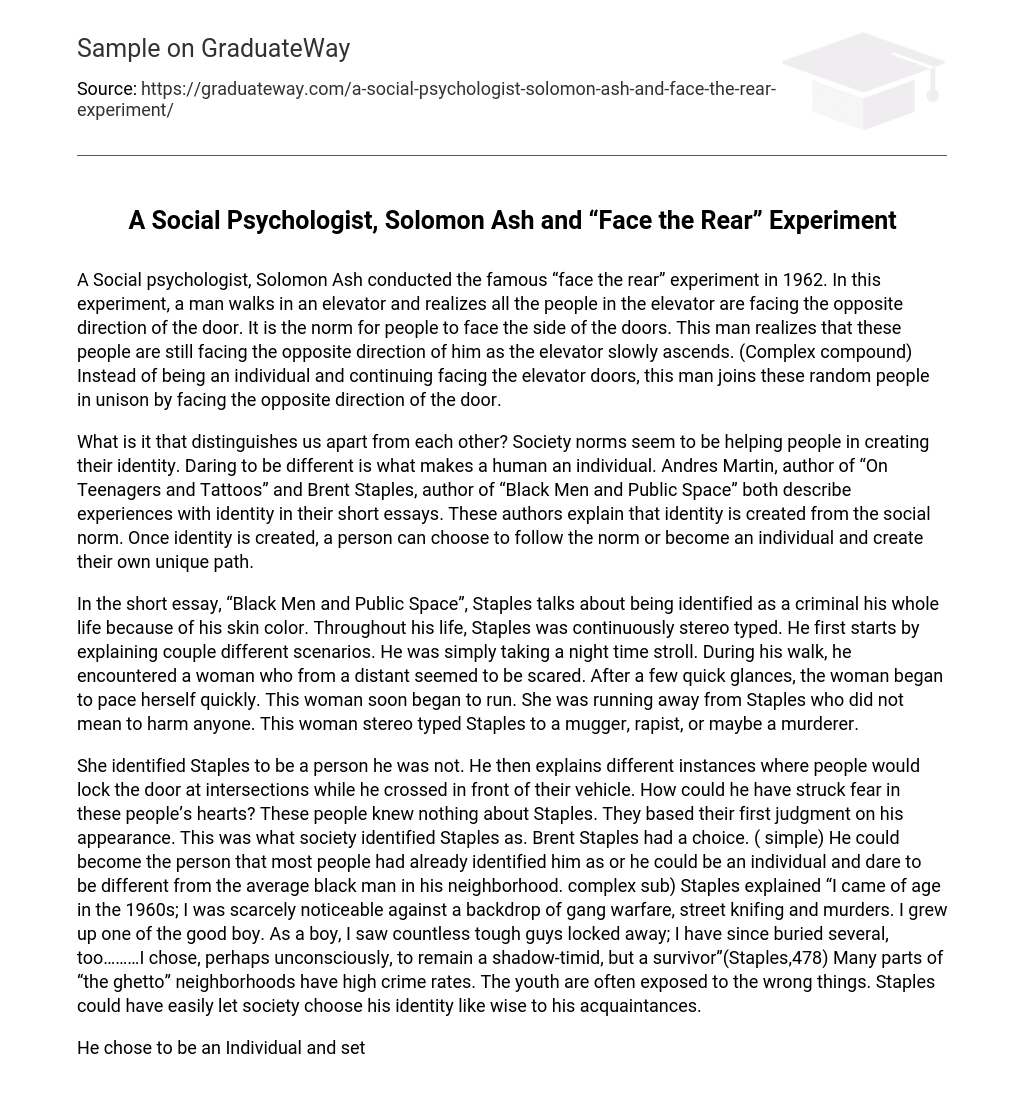A Social psychologist, Solomon Ash conducted the famous “face the rear” experiment in 1962. In this experiment, a man walks in an elevator and realizes all the people in the elevator are facing the opposite direction of the door. It is the norm for people to face the side of the doors. This man realizes that these people are still facing the opposite direction of him as the elevator slowly ascends. (Complex compound) Instead of being an individual and continuing facing the elevator doors, this man joins these random people in unison by facing the opposite direction of the door.
What is it that distinguishes us apart from each other? Society norms seem to be helping people in creating their identity. Daring to be different is what makes a human an individual. Andres Martin, author of “On Teenagers and Tattoos” and Brent Staples, author of “Black Men and Public Space” both describe experiences with identity in their short essays. These authors explain that identity is created from the social norm. Once identity is created, a person can choose to follow the norm or become an individual and create their own unique path.
In the short essay, “Black Men and Public Space”, Staples talks about being identified as a criminal his whole life because of his skin color. Throughout his life, Staples was continuously stereo typed. He first starts by explaining couple different scenarios. He was simply taking a night time stroll. During his walk, he encountered a woman who from a distant seemed to be scared. After a few quick glances, the woman began to pace herself quickly. This woman soon began to run. She was running away from Staples who did not mean to harm anyone. This woman stereo typed Staples to a mugger, rapist, or maybe a murderer.
She identified Staples to be a person he was not. He then explains different instances where people would lock the door at intersections while he crossed in front of their vehicle. How could he have struck fear in these people’s hearts? These people knew nothing about Staples. They based their first judgment on his appearance. This was what society identified Staples as. Brent Staples had a choice. ( simple) He could become the person that most people had already identified him as or he could be an individual and dare to be different from the average black man in his neighborhood. complex sub) Staples explained “I came of age in the 1960s; I was scarcely noticeable against a backdrop of gang warfare, street knifing and murders. I grew up one of the good boy. As a boy, I saw countless tough guys locked away; I have since buried several, too………I chose, perhaps unconsciously, to remain a shadow-timid, but a survivor”(Staples,478) Many parts of “the ghetto” neighborhoods have high crime rates. The youth are often exposed to the wrong things. Staples could have easily let society choose his identity like wise to his acquaintances.
He chose to be an Individual and set himself apart from others. Staples could not change his identity because that is the color of his skin, but as a solution he changed his clothing selection. He exchanged his jeans for business attire. This gave Staples a new look upon first appearance. Staples would define individuality as taking a person’s identity and setting it apart from others and not letting the status quo decides who to be. In the short story, “on Teenagers and Tattoos”, Andres Martin discusses how young teens get tattoos to be fashionable. Like hairdo, makeup or baggy jeans, tattoos and piercing can be subject to fad influences or peer pressure affiliation. ”(Martins, 388) This means that teens are doing do this to try and develop an individuality. All people are capable of getting a tattoo the types of tattoos, but the type of tattoos they get sets them apart from others. Martin continues by explaining “Tattoos and piercings can offer a concrete and readily available solution for many identity crises”. Teens are making a decision on what group in society they want to be in by getting tattoos.
Martin finishes by basically explaining that tattoo solve the identity problem and the differentiation of tattoos is what brings the person’s individuality. Deciding what type of tattoo a person gets, decides on what group they want to be a part of. Deciding what combination of tattoos and what part of the body the tattoo will be on is what makes a person individual. Andres Martin might define identity as what group a person wants to be in society and individuality to be what distinguishes people of that group from each other. Andres Martin and Brent Staples define both describe identity to be how society labels a person.
They explain identity is created by society, but individuality is how the person alters their identity in a unique way of their choosing. Individuality can only be formed by the person knowing their identity. Martins quotes a young teenager saying, “If I don’t want to fit in, it’s because I say so! ”(Martin, 389 ) Once a person decides on who they are or what they want to be in life, they now have the power to make decisions on how they want to live their life.
Work Cited:
Staples, Brent. “Black men in Public Space”. Wadswoth: Lyn Uhl, 2012. Print. Andres, Martins. ”On teenagers and Tattoos”. Wadswoth: Lyn Uhl, 2012. Print.





